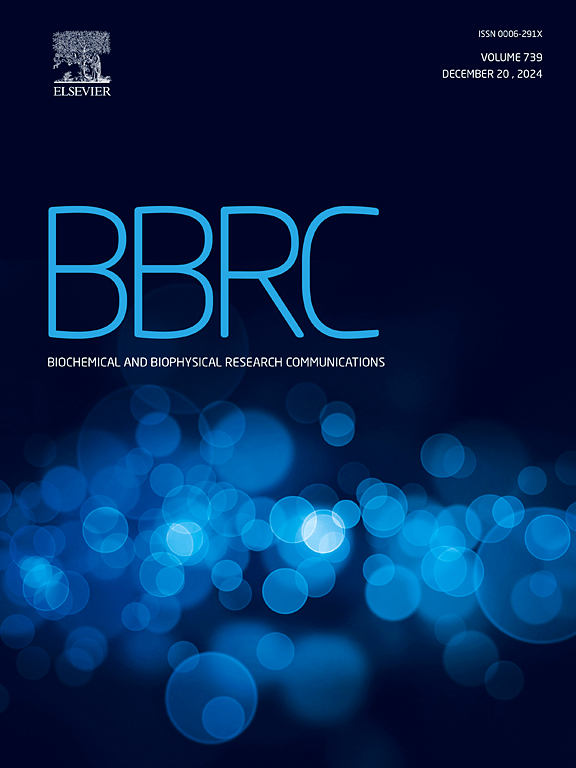Double-stranded RNA adenosine deaminases suppress ferroptosis through regulating SCD1
IF 2.5
3区 生物学
Q3 BIOCHEMISTRY & MOLECULAR BIOLOGY
Biochemical and biophysical research communications
Pub Date : 2025-06-18
DOI:10.1016/j.bbrc.2025.152218
引用次数: 0
Abstract
Double-stranded RNA adenosine deaminases 1 and 2 (ADAR1/2) are enzymes that convert adenosine to inosine (A-to-I), a major RNA editing event. A-to-I editing is strongly correlated with cancer progression and drug resistance. While the role of ADAR1/2 in apoptosis regulation in certain cancer types is well-characterized, their potential involvement in ferroptosis has not been explored. In this study, we report that ADAR1/2 are upregulated in cervical, breast, and colon cancers but have no impact on drug-induced apoptosis. Depletion of ADAR1/2 resulted in increased lipid droplets and downregulated Stearoyl-CoA desaturase 1 (SCD1), a lipogenic enzyme that protects cells from lipid peroxidation and ferroptosis. ADAR1/2 and SCD1 expressions are positively correlated at both mRNA and protein levels in cancers with elevated ADAR1/2. Cells depleted of ADAR1/2 were sensitized to RSL3-induced ferroptosis. Furthermore, cells stably overexpressing wild-type ADAR1 (WT) remained resistant to ferroptosis with strong SCD1 expression, whereas cells with an RNA editing-inactive mutant (EAA) were sensitive with diminished SCD1 levels. WT cells became susceptible to RSL3-induced ferroptosis when SCD1 was depleted. These results indicate that ADAR1/2 suppress ferroptotic cell death via RNA editing activity, specifically through SCD1 regulation.
Collectively, our findings highlight the suppressive role of ADAR1/2 in ferroptosis and reveal a novel function of ADAR1/2 in regulating this process. These results suggest that targeting ADAR1/2 could offer a promising strategy to overcome chemotherapeutic resistance in cancers with elevated RNA editing.
双链RNA腺苷脱氨酶通过调节SCD1抑制铁下垂
双链RNA腺苷脱氨酶1和2 (ADAR1/2)是将腺苷转化为肌苷(a -to- i)的酶,这是一个主要的RNA编辑事件。A-to-I编辑与癌症进展和耐药性密切相关。虽然ADAR1/2在某些癌症类型的细胞凋亡调节中的作用已经被充分描述,但它们在铁下垂中的潜在参与尚未被探索。在这项研究中,我们报道ADAR1/2在宫颈癌、乳腺癌和结肠癌中上调,但对药物诱导的细胞凋亡没有影响。ADAR1/2的缺失导致脂滴增加和硬脂酰辅酶a去饱和酶1 (SCD1)的下调,SCD1是一种脂质生成酶,可保护细胞免受脂质过氧化和铁凋亡。在ADAR1/2升高的癌症中,ADAR1/2和SCD1的mRNA和蛋白水平均呈正相关。ADAR1/2缺失的细胞对rsl3诱导的铁下垂敏感。此外,稳定过表达野生型ADAR1 (WT)的细胞对SCD1强表达的铁凋亡仍然具有抗性,而具有RNA编辑失活突变体(EAA)的细胞对SCD1水平降低敏感。当SCD1缺失时,WT细胞易发生rsl3诱导的铁下垂。这些结果表明ADAR1/2通过RNA编辑活性,特别是通过SCD1调控抑制铁嗜性细胞死亡。总之,我们的研究结果强调了ADAR1/2在铁下垂中的抑制作用,并揭示了ADAR1/2在调节这一过程中的新功能。这些结果表明,靶向ADAR1/2可能提供一种有希望的策略,以克服RNA编辑水平升高的癌症的化疗耐药。
本文章由计算机程序翻译,如有差异,请以英文原文为准。
求助全文
约1分钟内获得全文
求助全文
来源期刊
CiteScore
6.10
自引率
0.00%
发文量
1400
审稿时长
14 days
期刊介绍:
Biochemical and Biophysical Research Communications is the premier international journal devoted to the very rapid dissemination of timely and significant experimental results in diverse fields of biological research. The development of the "Breakthroughs and Views" section brings the minireview format to the journal, and issues often contain collections of special interest manuscripts. BBRC is published weekly (52 issues/year).Research Areas now include: Biochemistry; biophysics; cell biology; developmental biology; immunology
; molecular biology; neurobiology; plant biology and proteomics

 求助内容:
求助内容: 应助结果提醒方式:
应助结果提醒方式:


